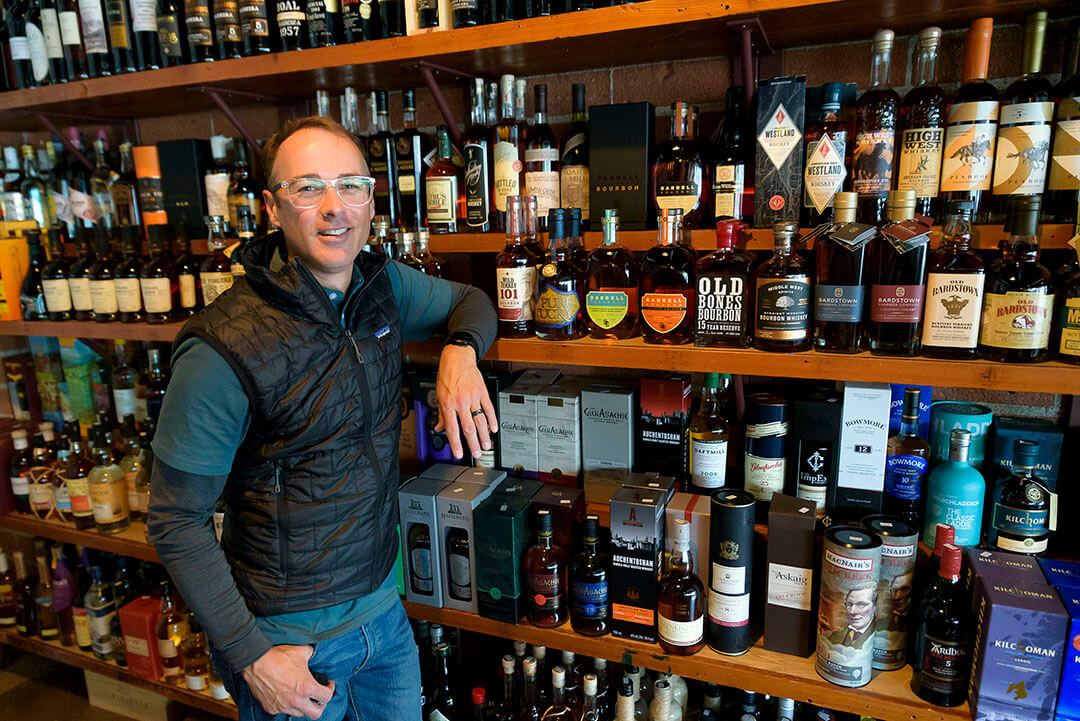Your guide to tasting, buying, and loving whiskey.
Whiskey’s golden-brown color, warm aroma, and complex taste make it a favorite spirit for many, but for newcomers, the strong, almost obnoxious alcohol burn might interfere with that experience. As with any food or drink, enjoying whiskey requires training your palate. Most people don’t visit a Thai or Indian restaurant and order the highest spice level, and they don’t start with Italian roast black coffee either. We work our way into it, maybe with a level one pad Thai or a nice vanilla latte to start.
So it goes with whiskey. It’s better to start with some basic knowledge and slowly adapt and grow into it. Your journey could be a short jump from a cocktail to ordering Scotch neat, or it could be a lifelong relationship that ages and grows more complex over time.
“The way I got into whiskey was smelling it — I used to fill the decanters in limousines at the hotel where I worked,” says Ty Martin, owner of Craft Wine & Beer in Midtown Reno. “At first, I hated it. And these were brands like Crown Royal, Hennessy, and Jack Daniels — not particularly complex spirits, but they’re incredibly aromatic. Of course, the flavor of most things is in the smell, not just the taste on your tongue.”
Martin has since become a veritable expert on wine and spirits. Anyone asking a question at his store will be showered with an encyclopedic knowledge of the makers of that spirit and its flavors.

Get to Know Whiskey
To start your experience, Martin recommends sidling up to a bar with a wide array of whiskeys, such as Chapel Tavern in Midtown, Bank Saloon in Downtown Carson City, or Mamma Celeste’s Gastropub & Pizzeria in Sparks, and starting with a whiskey cocktail before picking up an expensive bottle at the store and drinking it at home. Bartenders recommend avoiding the rush by coming in midweek afternoons, if you want to really dig into the nuances with them. Between these three bars, you’ll have access to hundreds of options, but don’t get too overwhelmed; let the bartender be your guide.
Starting with a Manhattan or old fashioned cocktail and picking a particular brand from the list below is a good way to taste a sweetened version of that whiskey, so it’s not overpowering. Try the same cocktail more than once, with different bourbons and ryes to help you understand the difference between the sweeter, more vanilla-forward bourbon and the spicy rye.
Ask the bartender to set out the bottle (if they don’t already) so you can read the label, smell the spirits within, and get to know it.
“You’re just sweetening it and adding a little bitters,” Martin says. “But it has been transformed enough that it would be a good way to get your feet wet if you’re not ready for straight whiskey.”
If you enjoy the two whiskey cocktails Martin has recommended and are ready to explore a bit more, there’s no reason to jump headfirst into drinking whiskey neat just yet. Instead, try out some drier Irish and Scotch whiskey cocktails to get a feel for what comes next.
Start by Sampling
Whiskeys take on different scent and flavor profiles depending upon the grains used and barrels in which they’re aged. Part of the joy is learning to detect them, name them — no matter how strange — and develop preferences for some over others. Scotch tends to have more flavor varieties, depending on the regions where they’re made, than bourbon, for example. This is similar to how coffee tastes and smells differently depending on the origin and roast, or how wine is influenced by the climate and soil where the grapes were grown or the barrels in which it was aged.
We recommend trying a few top-shelf whiskeys at the bar first before committing to buying a bottle to take home. This requires a little bit of research online and some conversations with a knowledgeable bartender.
Tell the bartender what flavors you’re in the mood for and sneakily read about them on your phone before and after ordering. People have reported tasting any number of flavors in whiskey, from green apples and brown sugar to, bizarrely enough, medicinal flavors such as children’s Tylenol (seriously) and Band-aids, charcoal, or any other of the hundreds of existing flavors or textures. Try a few and visualize the flavors as you hold the whiskey in your mouth. Breathe. Swallow. Ignore the Pappy Van Winkle; you’ll never find it in stores anyway, Martin says.
If you’ve progressed this far on your whiskey journey, it’s time to commit to the idea of drinking your whiskey neat, or at least with water or on ice, but not in a cocktail. Adding drops of water or ice changes the flavor and smell by mixing with the oils and softening everything.
“If your whiskey buddy tells you, ‘You don’t dilute whiskey,’ he’s an idiot,” Martin says. “Don’t listen to that guy. He’s not going to be your mentor in whiskey.”
Get Acquainted with the Label
Head back to the store with your new knowledge. Plan to spend more than $65 but less than $125 for a good bottle. Pick a style of whiskey from the list below that falls in your taste range. Look for something at least seven years old, although 10 to 16 years is ideal, as this helps ensure you get less alcohol burn and allows the flavor to shine through when drinking it. Read the label (see “How to Read a Whiskey Label” in this issue to decipher it) to learn about its features. Consider getting a good rocks glass/tumbler or tulip set — maybe get a monocle, too.
Brands to Consider
Martin recommends that when you’re ordering your first whiskey cocktails, such as the Manhattan or old fashioned, consider requesting the brands listed below.
Stick with bourbon and rye to start; this is a good place to prime your palate. Read the bottles or look them up online to get a sense of their flavor profiles. Take note of what you like and branch out from there. Then enjoy learning as you go.
Pro Tips for Whiskey Purchases
So now that you’ve got a taste for whiskey, it’s time to purchase a bottle or two and expand your palate.
Typically, this involves walking into the liquor store and standing in front of the overflowing whiskey/Scotch shelves. The bottles stare back at you. Suddenly you’re doing math about the age of the liquid within. Half of these bottles aren’t even old enough to drink; the other half are older than you. You freeze, pick the best-looking label at a modest $40 price point. You take it home and it seems fine, but you wanted something more. It sits for too long until you finish it and the cycle begins anew.
It’s time to break the cycle. Taking a bottle of whiskey home requires commitment to a flavor you like, a region about which you want to learn, and a story you want to tell guests.
Now Share It
Take it home and gather all your friends around the new bottle you’ve procured. Pour the whiskey into your new glassware. Get a glass of water and straws, dip the straw into the water and collect a little water in it, then release a small amount of water into the whiskey. Smell it with your mouth open, then sip it. Decide if it needs more water. Read the label or check online for tasting notes to read aloud to all your friends. Solicit feedback, and take notes. Make plans for the next bottle.
Repeat forever.
Mike Higdon is a Nevada native who loves to tell stories about, and drink, tasty beverages of all kinds, especially around the campfire. He enjoys Islay and Speyside Scotches.
SIDEBAR
Understanding Whiskey Styles
Whiskey is a large category of liquors distilled from any variation of cereal grains, including barley, oats, corn, and rye, and then aged in a barrel anywhere from a few minutes to 25 or more years.
Included in the whiskey category are several styles. This is similar to how beer includes IPAs, stouts, pale ales, and a myriad of other styles.
Bourbon: Comprised of at least 51 percent corn, made mostly in the United States (but not always) and aged in new oak barrels. Mostly vanilla and woody flavors, very dark and often spicy and heavy. Includes Kentucky, Tennessee, and general American whiskey variations
Rye: Made primarily of rye grass. Similar to bourbon, but much spicier
Irish whiskey: Made in column stills for additional filtration. Very clean, smooth, and light
Scotch: Made exclusively in Scotland with only malted barley. Produced in one of five distinct regions of Scotland, with each region producing its own type of whiskey (or whisky, the traditional Scottish spelling). Flavors can range dramatically from light and floral to heavy, peaty (or not), spicy, smoky, and even iodine, among others. Generally considered the most varied whiskey and most known for single-malt Scotch varieties
Canadian and Japanese: Regional variations based on Scotch. Tend toward being sweeter, spicier, fruitier, and lighter overall
Blended whiskey: Major variations that come from blending any two or more products from more than one distillery to create a new product
SIDEBAR
Understanding Whiskey Styles
Whiskey is a large category of liquors distilled from any variation of cereal grains, including barley, oats, corn, and rye, and then aged in a barrel anywhere from a few minutes to 25 or more years.
Included in the whiskey category are several styles. This is similar to how beer includes IPAs, stouts, pale ales, and a myriad of other styles.
Bourbon: Comprised of at least 51 percent corn, made only in the United States and aged in new oak barrels. Mostly vanilla and woody flavors, very dark and often spicy and heavy. Includes Kentucky, Tennessee, and general American whiskey variations
Rye: Made primarily of rye grass. Similar to bourbon, but much spicier
Irish whiskey: Very clean, smooth, and light most of the time with varying complexity. Four major variations set Irish whiskey apart from the others
Scotch: Made exclusively in Scotland with only malted barley. Produced in one of five distinct regions of Scotland, with each region producing its own type of whiskey (or whisky, the traditional Scottish spelling). Flavors can range dramatically from light and floral to heavy, peaty (or not), spicy, smoky, and even iodine, among others. Generally considered the most varied whiskey and most known for single-malt Scotch varieties
Canadian: Tends to be sweeter, spicier, fruitier, and lighter overall. Canadian whiskeys tend to be blended instead of using single-origin ingredients. Most use rye and corn
Japanese: Inspired by Scotch but with wildly different flavors. Much lighter, more delicate, and inspired by Japanese culinary culture
Blended whiskey: Major variations that come from blending any two or more products from more than one distillery to create a new product. Every major category does some blended version
Whiskeys to Try
Auchentoshan Single-Malt Scotch
Frey Ranch rye (produced in Fallon, Nev.)
Four Roses Single Barrel bourbon
George Dickel Tennessee Whiskey
Glenfarclas Single-Malt Scotch
Glenkinchie Single-Malt Scotch
Green Spot Irish whiskey
Hibiki Japanese blended whisky
Jim Beam Black
Maker’s Mark bourbon
Nikka Coffey Grain Japanese whisky
Old Grand-Dad bourbon
Old Overholt Rye
WhistlePig PiggyBack Rye
Wild Turkey 101 bourbon
Yellow Spot Irish whiskey
Resources
The following locations are excellent places to start your adventure in whiskey tasting.
Bank Saloon
418 S. Carson St., Carson City
775-301-6710 • Banksaloonnv.com
Offers a wide selection of unique, handcrafted whiskey cocktails and 35 whiskey brands.
Craft Wine & Beer
22 Martin St., Reno
775-622-4333 • Craftreno.net
Carries more than 90 types of whiskey.
Mamma Celeste’s Gastropub & Pizzeria
360 Los Altos Pkwy., Ste. 180, Sparks
775-626-0200 • Mammaceleste.com
Offers a comprehensive menu of 40 whiskeys, including local brands.


